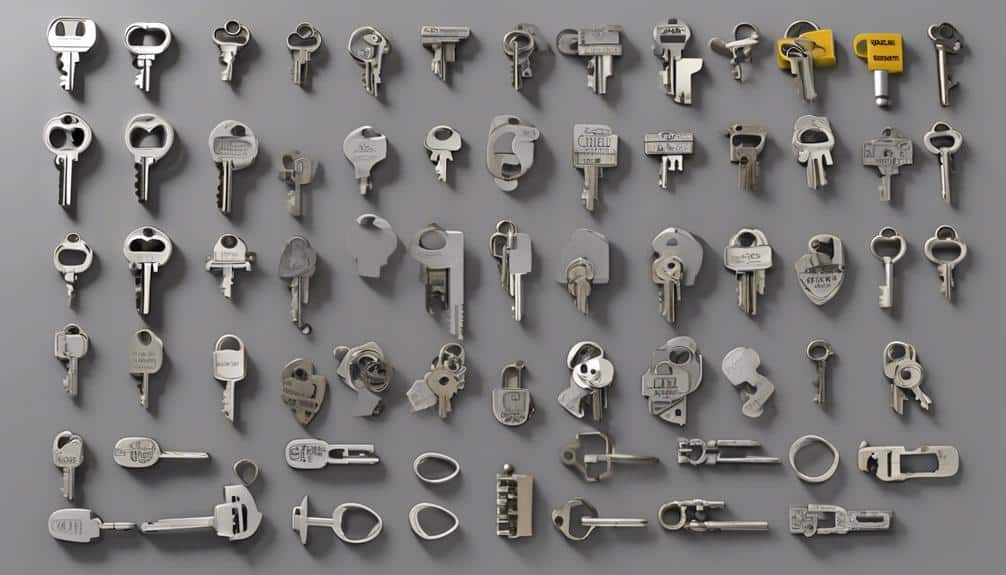When it comes to duplicating pushbutton lock keys, it's like unraveling a mystery. Each key holds a secret, a unique combination of pins and depths that must be deciphered. But fear not, for we are here to guide you through the process.
In this discussion, we will reveal nine essential tips that will unlock the secrets of duplicating pushbutton lock keys. So, join us on this journey of discovery as we unravel the complexities and provide you with the knowledge you need to master this intriguing art.
Understanding Pushbutton Locks
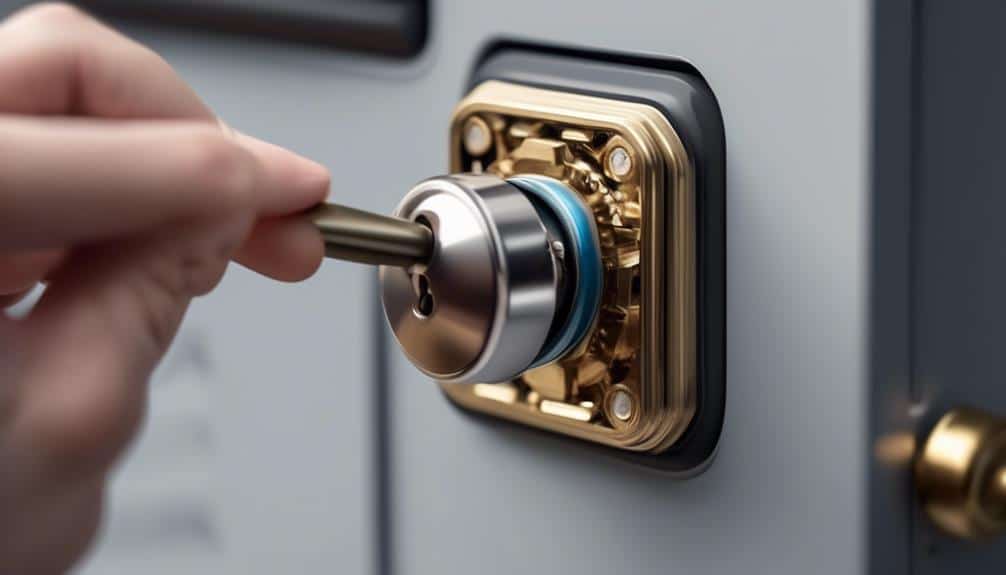
Understanding pushbutton locks is essential for anyone looking to duplicate keys for these types of locks. Pushbutton locks are a popular choice for both residential and commercial properties due to their convenience and ease of use. However, duplicating keys for these locks can be challenging if you aren't familiar with their specific features and requirements.
One of the most common mistakes in duplicating pushbutton lock keys is failing to accurately measure the depths of the lock pins. Pushbutton locks use a series of pins with varying depths to engage the lock mechanism. To duplicate a key successfully, it's crucial to measure and replicate these depths accurately. Failing to do so can result in a key that doesn't work or only partially engages the lock.
When choosing a key duplicating machine for pushbutton locks, several factors should be considered. First, ensure that the machine is capable of accurately measuring and replicating the depths of the lock pins. Look for a machine that offers precision and reliability. Additionally, check if the machine supports the specific type of key used in pushbutton locks, as there can be variations in key shapes and sizes.
Gathering Necessary Tools
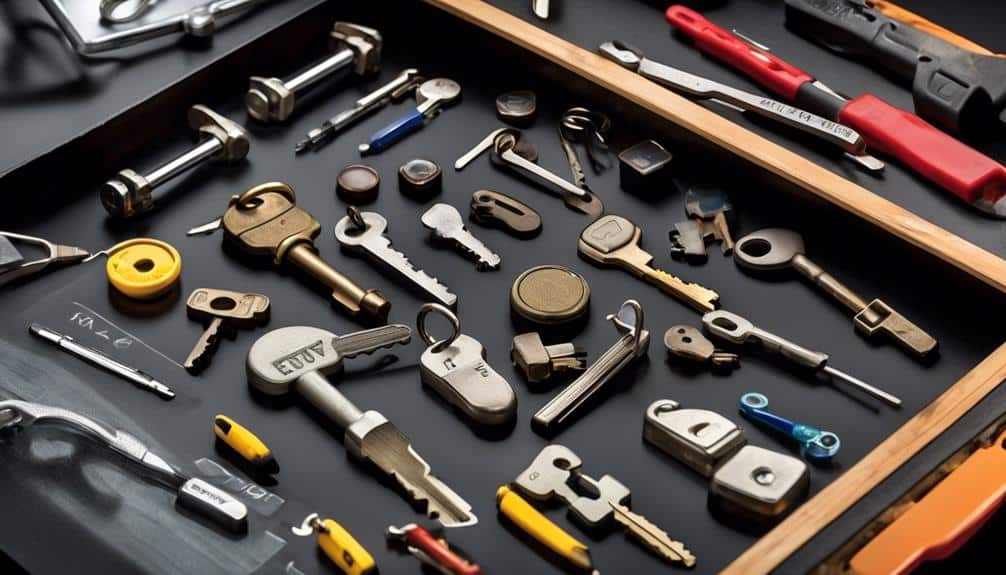
To successfully duplicate pushbutton lock keys, we need to gather the necessary tools. These tools include a key duplicator machine, a blank key, and a pushbutton lock.
The key duplicator machine is used to create an exact copy of the original key, while the blank key serves as the template for the duplication process.
Once we have these tools ready, we can proceed to obtain the original key and follow the necessary steps to duplicate it accurately.
Tools Needed for Duplication
To gather the necessary tools for duplicating pushbutton lock keys, we can optionally use an assortment of locksmith equipment. Here are three essential tools needed for duplication:
- Key cutting machine: A key cutting machine is a specialized tool used to cut the key blank into the desired shape and size. It ensures precision and accuracy during the duplication process.
- Key blanks: These are blank keys that will be used to create a duplicate. It's important to choose the correct key blank that matches the original key to ensure a proper fit.
- Key identification tools: These tools help in identifying the type and model of the pushbutton lock key. They allow locksmiths to determine the specific key blank needed for duplication.
Before using these tools, it's crucial to prepare the key blank by cleaning it thoroughly and ensuring it's free from any dirt or debris. This will help to avoid any issues during the duplication process and ensure a successful outcome.
Obtaining the Original Key
After gathering the necessary tools for duplicating pushbutton lock keys, the next step is to obtain the original key. This is a crucial part of the key duplication process as it ensures accuracy and effectiveness. To obtain the original key, you need to have a thorough understanding of the key duplication process and choose the right key blank.
The table below illustrates the key duplication process:
| Steps to Obtain the Original Key | Description |
|---|---|
| Step 1 | Identify the type of pushbutton lock. |
| Step 2 | Examine the original key for any unique features or markings. |
| Step 3 | Select the appropriate key blank that matches the original key. |
| Step 4 | Use a key cutting machine to cut the key blank to match the original key. |
| Step 5 | Test the newly cut key on the pushbutton lock to ensure it functions properly. |
Steps for Key Duplication
We will now discuss the necessary tools required for duplicating pushbutton lock keys.
When duplicating pushbutton lock keys, it's crucial to have the right tools to ensure accuracy and precision. Here are three essential tools you'll need:
- Key duplicator machine: This machine is specifically designed for duplicating keys and ensures precise cutting of the key's grooves and notches. It's important to choose a key duplicator machine that's compatible with pushbutton lock keys.
- Key blanks: These are blank keys that will be used as a template for duplicating the original key. It's important to select key blanks that match the size and shape of the original key to ensure a perfect duplication.
- Calipers: These measuring tools are used to accurately measure the dimensions and depths of the original key's grooves and notches. By using calipers, you can ensure that the duplicated key matches the original key precisely, guaranteeing a functioning duplicate.
Identifying the Key Type
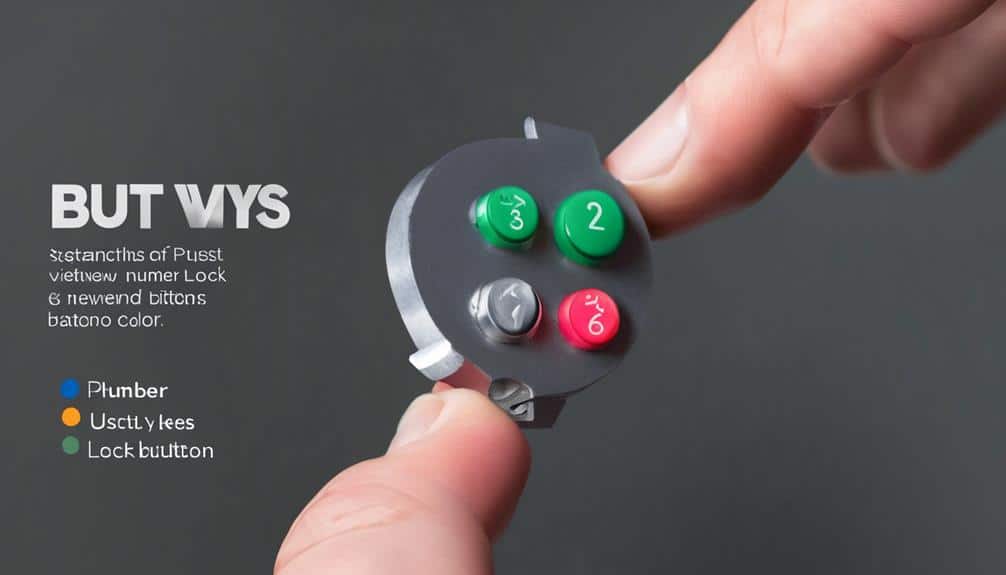
By examining the physical characteristics of the key, such as its shape and size, we can accurately identify the type of key used in a pushbutton lock. When it comes to identifying key types, it's important to pay attention to even the smallest details.
One common mistake when duplicating keys is assuming that all pushbutton locks use the same type of key. However, pushbutton locks can come in various types, each requiring a unique key shape and size.
To accurately identify the key type, start by observing the shape of the key. Pushbutton lock keys can have different shapes, such as flat, tubular, or angled. Additionally, note the size of the key. Some keys may be smaller or larger than others, depending on the lock's design.
It is also crucial to examine any grooves or ridges on the key. These features can indicate the type of locking mechanism used and provide important clues for duplication. Furthermore, look for any markings or symbols on the key, as they can give further insight into the key type.
Preparing the Key Blank
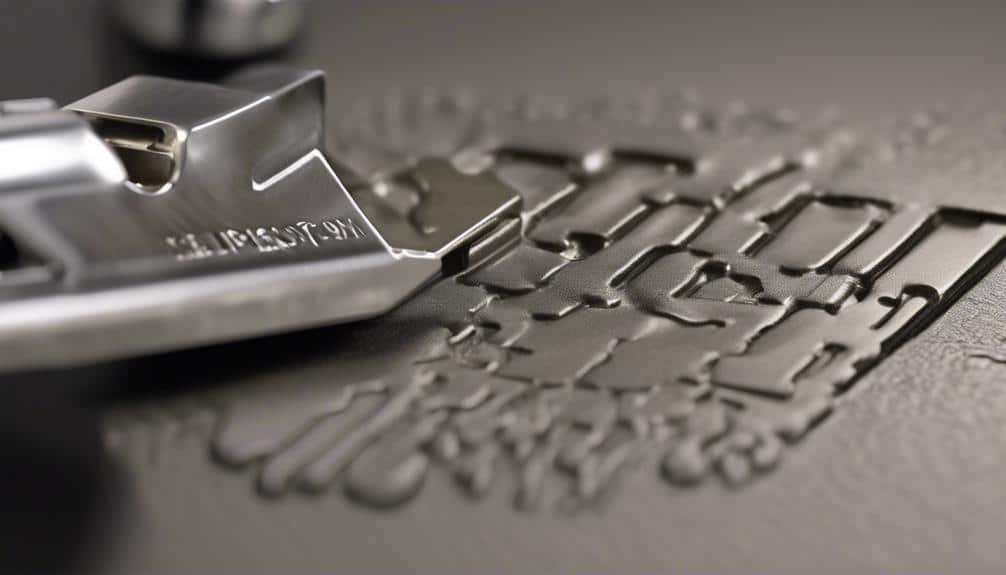
To prepare the key blank for duplication, carefully measure and assess its dimensions and features. This step is crucial to ensure that the duplicated key will fit and function properly in the pushbutton lock.
Here are three essential tasks to undertake during the preparation of the key blank:
- Key blank selection: Choose a blank that matches the original key in terms of its size, shape, and compatibility with the pushbutton lock. Consider the brand and model of the lock to ensure a perfect fit.
- Key blank shaping: Use a file or key cutting machine to shape the key blank according to the original key's profile. Follow the contours and depths of the cuts precisely to ensure accurate duplication. Take your time and carefully remove any excess material to achieve the desired shape.
- Key blank deburring: After shaping the key blank, it's essential to remove any rough edges or burrs that may interfere with smooth insertion and turning of the key. Use a deburring tool or file to gently smooth out any imperfections, ensuring a clean and functional duplicate.
Using a Key Duplicating Machine
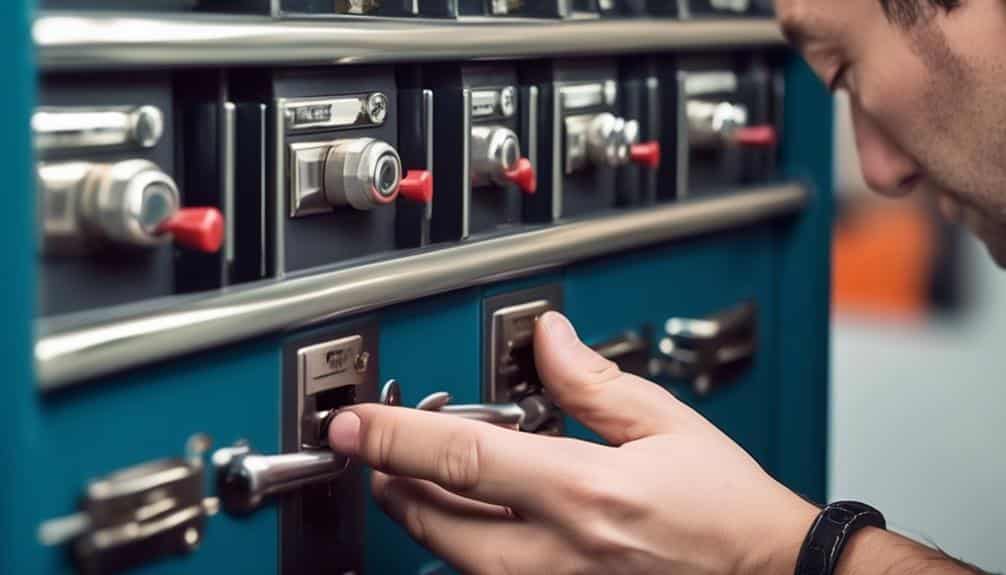
Using a key duplicating machine allows for efficient and accurate duplication of pushbutton lock keys. These machines are specifically designed to replicate the grooves and ridges of the original key onto a blank key, ensuring a precise fit and smooth operation. Key duplication machines come in various types, such as manual, semi-automatic, and automatic machines.
To duplicate a pushbutton lock key using a key duplicating machine, start by selecting the appropriate key blank that matches the original key's dimensions and design. Then, secure the original key and the blank key onto the machine's clamping mechanism. Adjust the machine's settings, such as depth and speed, based on the specific key duplicating technique required for the pushbutton lock key.
Once everything is set up, activate the machine, and it will begin the duplication process. The machine's cutting mechanism will trace the contours of the original key while cutting the corresponding grooves onto the blank key. This process ensures an accurate replication of the original key's shape, ensuring compatibility with the pushbutton lock.
After the cutting process is complete, remove the duplicated key from the machine and carefully inspect it for any imperfections. Make any necessary adjustments or corrections using the machine's fine-tuning features. Finally, test the duplicated key on the pushbutton lock to ensure it works smoothly and securely.
Using a key duplicating machine simplifies the key duplication process, allowing for efficient and precise replication of pushbutton lock keys.
Checking for Compatibility
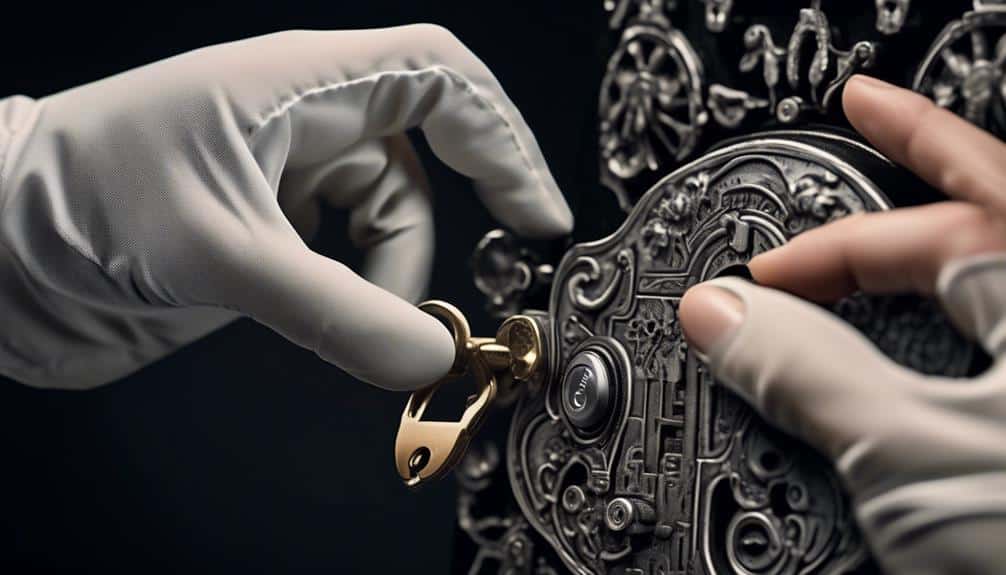
To ensure a successful duplication, it's essential to verify the compatibility of the duplicated key with the pushbutton lock. Compatibility testing ensures that the key will work seamlessly with the lock, minimizing the risk of malfunction or damage.
Here are three key factors to consider when checking for compatibility:
- Key Profile: The key profile refers to the shape and size of the key. It's important to ensure that the duplicated key matches the original key's profile precisely. Any deviation in the profile can result in the key not fitting properly into the lock or not turning smoothly.
- Key Material: The material used to make the key can also affect compatibility. Different locks are designed to work with specific key materials. It's crucial to use the same material for the duplicated key to ensure optimal performance.
- Key Code: Some pushbutton locks require a specific key code for compatibility. Before duplicating the key, it's important to determine if the lock has a key code and if the duplicated key needs to match that code. Failure to match the key code can render the duplicated key incompatible with the lock.
Adjusting for Pin Depths
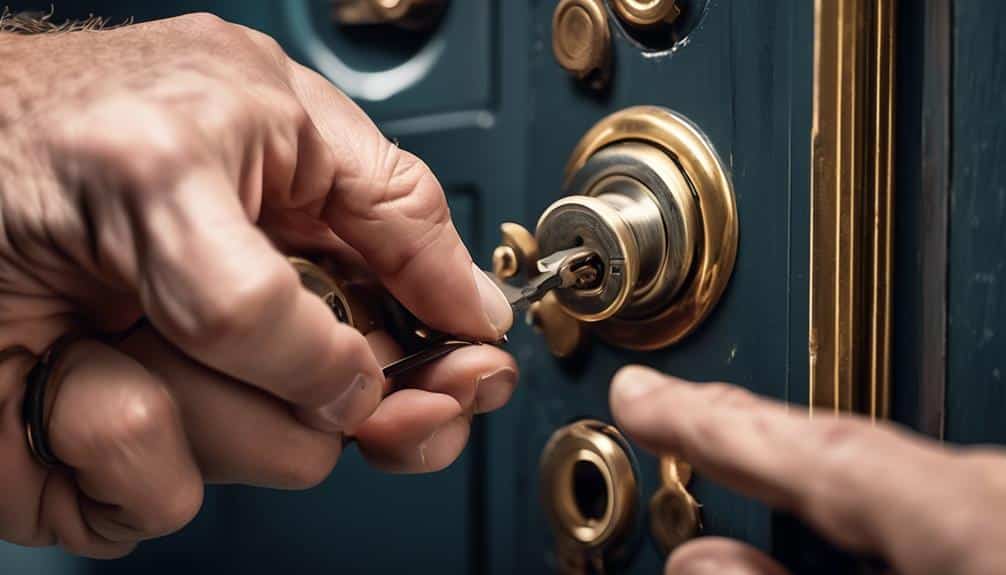
When it comes to duplicating pushbutton lock keys, adjusting for pin depths is a crucial step. Pin depth adjustment techniques play a vital role in ensuring the accuracy and functionality of the duplicated key.
Pin depth calibration is necessary to achieve precision in replicating the pin depths of the original key, ensuring a seamless fit and proper functioning of the duplicate key.
Pin Depth Adjustment Techniques
We can adjust for pin depths by employing various techniques that allow us to achieve precise and accurate results. When it comes to pin depth adjustment, there are several methods that can be used. Here are three techniques to consider:
- Incremental adjustment: This technique involves making small, incremental changes to the pin depth until the desired result is achieved. By carefully measuring the current pin depth and making slight adjustments, we can gradually fine-tune the lock for optimal performance.
- Depth gauge tools: Using depth gauge tools can greatly simplify the process of adjusting pin depths. These tools allow us to measure the current pin depth and make precise adjustments based on the desired pin depth standards. By using a depth gauge tool, we can ensure consistent and accurate results.
- Trial and error: This technique involves making initial pin depth adjustments and then testing the lock's functionality. By repeatedly making adjustments and testing the lock, we can determine the optimal pin depth for smooth operation.
Pin Depth Calibration
After implementing the pin depth adjustment techniques discussed, the next step in achieving optimal lock performance is pin depth calibration. Pin depth calibration ensures that each pin is set to the correct depth, allowing for smooth operation of the lock.
To calibrate the pin depths, start by using a depth gauge to measure the current depth of each pin. Compare the measured depth to the desired depth for each pin as specified by the manufacturer. If any discrepancies are found, adjustments can be made using various pin depth adjustment methods such as filing or adding shims.
It's crucial to calibrate the pin depths accurately to avoid potential issues such as jamming or difficulty in turning the key. Regularly checking and troubleshooting pin depth errors will help maintain the security and functionality of the lock system.
Precision in Pin Depths
To ensure precise pin depths, adjustments can be made using various methods such as filing or adding shims. Pin depth measurement is a critical step in duplicating pushbutton lock keys accurately. Here are three essential considerations for achieving precision in pin depths:
- Key Blank Selection: Choosing the correct key blank is crucial for achieving accurate pin depths. Different key blanks have varying depths, and using the wrong one can lead to misalignment and ineffective key duplication. Carefully examine the original key and select a blank that closely matches its pin depths.
- Filing: If the pin depth on the key blank is too shallow, filing can be used to increase its depth. This method involves removing small amounts of material from the key blank's pin chambers until the desired depth is achieved. It requires precision and careful measurement to avoid over-filing.
- Shims: Adding shims is another method for adjusting pin depths. Shims are thin, flat pieces of material that can be inserted between the key blank and the lock cylinder to raise the pin depths. Shims come in various thicknesses, allowing for precise adjustments to match the original key's pin depths.
Testing the Duplicated Key
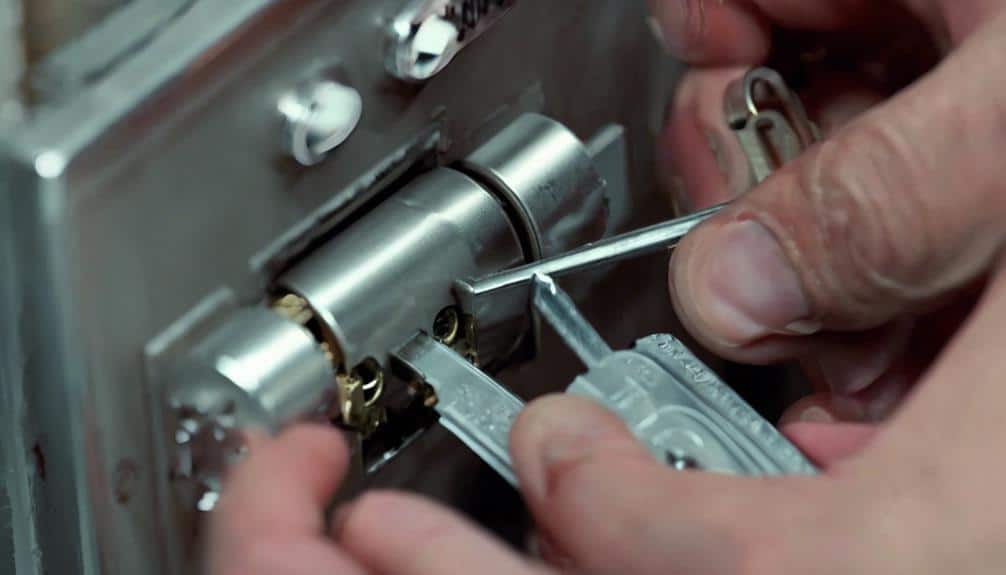
The duplicated key should be tested thoroughly to ensure its functionality and accuracy. Testing the accuracy of the duplicated key is crucial to ensure that it can successfully operate the pushbutton lock. Additionally, evaluating the durability of the key is important to determine its longevity and resistance to wear and tear.
To test the accuracy of the duplicated key, it is recommended to follow a systematic approach. Start by inserting the key into the lock and turning it to check if the lock mechanism engages smoothly. Ensure that the key is able to fully rotate without any resistance or sticking points. Next, test the key in different orientations to verify its functionality from various angles.
In order to evaluate the durability of the duplicated key, it is advisable to subject it to regular usage conditions. This includes repeatedly inserting, turning, and removing the key from the lock. Observe if any signs of wear or deformation occur, such as bending or breaking. Additionally, check if the key retains its shape and functionality over time.
Table: Testing the Duplicated Key
| Test | Procedure | Expected Result |
|---|---|---|
| Smooth Rotation | Insert key and turn in lock | Key rotates smoothly without resistance or sticking points |
| Orientation Variations | Test key from different angles | Key works consistently in all orientations |
| Regular Usage Conditions | Repeatedly insert, turn, and remove key | Key withstands usage without signs of wear or deformation |
Troubleshooting Common Issues
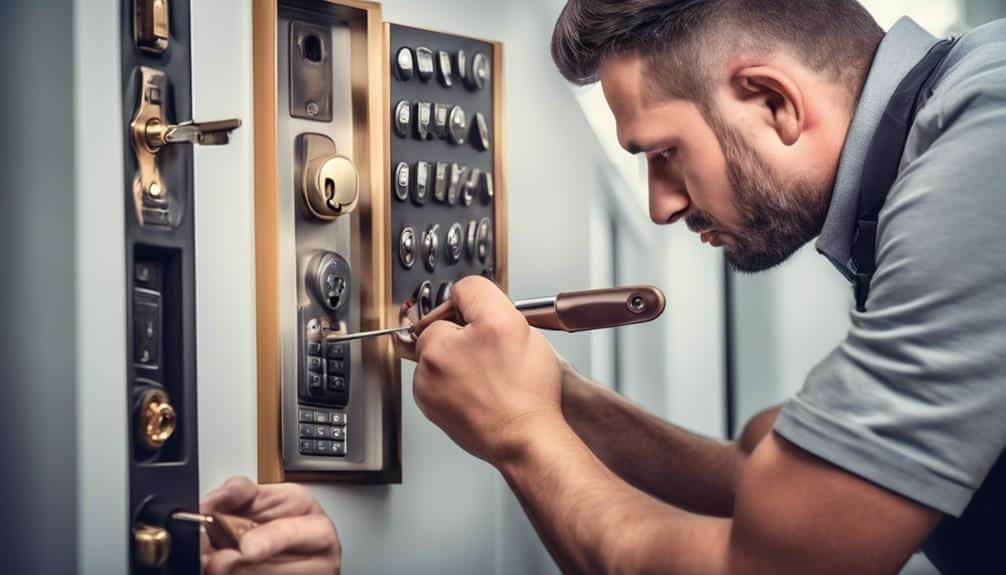
When troubleshooting common issues with duplicated pushbutton lock keys, it's important to carefully analyze and identify the specific problem before attempting any solutions.
Here are three common issues that may arise during the key duplication process:
- Misaligned buttons: One of the most common mistakes in key duplication is the misalignment of the buttons. This can cause the key to not function properly or fail to operate the lock altogether. To troubleshoot this issue, carefully compare the duplicated key with the original and ensure that the buttons are aligned correctly.
- Incorrect programming: Another common issue is incorrect programming of the duplicated key. This can occur if the programming sequence isn't followed accurately or if the wrong programming code is used. To troubleshoot this issue, refer to the lock's user manual and carefully follow the programming instructions step by step.
- Battery depletion: Sometimes, the duplicated key may not work due to battery depletion. Pushbutton lock keys are often battery-operated, and if the battery is low or dead, the key won't function properly. To troubleshoot this issue, replace the battery with a new one and test the key again.
Frequently Asked Questions
What Are Some Common Issues That Can Occur When Duplicating Pushbutton Lock Keys?
When duplicating pushbutton lock keys, we often encounter common challenges. These can include issues with the accuracy of the duplicated key, problems with the pushbutton lock's functionality, or difficulties in properly aligning the key with the lock mechanism.
To overcome these challenges, there are several troubleshooting techniques available. These include:
- Double-checking the original key for any damage or wear
- Ensuring the key cutting machine is calibrated correctly
- Making sure the duplicated key is tested thoroughly before final use.
Are There Any Specific Safety Precautions That Should Be Taken When Duplicating Pushbutton Lock Keys?
Proper safety precautions when duplicating pushbutton lock keys are crucial to avoid common mistakes.
It's important to wear protective gloves and goggles to prevent any injuries.
Additionally, ensure that the key duplication process is done in a well-ventilated area to avoid inhaling any harmful fumes.
Always use the correct tools and follow the manufacturer's instructions carefully.
Double-check the accuracy of the duplicated key before using it to ensure it functions properly and securely.
Can Pushbutton Lock Keys Be Duplicated for Any Type of Lock?
Pushbutton lock keys can't be duplicated for all types of locks due to limitations. However, there are alternatives to duplicating pushbutton lock keys. Some locks may require specialized equipment or professional assistance for key duplication.
It's crucial to understand the specific lock system and its limitations before attempting to duplicate pushbutton lock keys. By following proper procedures and seeking expert advice when needed, you can ensure the security of your lock system.
How Long Does It Typically Take to Duplicate a Pushbutton Lock Key?
On average, duplicating a pushbutton lock key can take around 5 to 10 minutes.
The process involves several steps, including:
- Analyzing the original key's structure
- Decoding the specific pushbutton pattern
- Replicating it onto a blank key
It requires precision and attention to detail to ensure that the duplicate key functions correctly.
Is It Possible to Duplicate a Pushbutton Lock Key Without Using a Key Duplicating Machine?
It is possible to duplicate a pushbutton lock key without using a key duplicating machine, but there are pros and cons to consider.
The main advantage is cost savings, as manual duplication methods are typically cheaper. However, manually duplicating pushbutton lock keys requires a higher level of skill and precision, and there's a greater risk of errors.
Alternatives to key duplicating machines include using a file or a locksmith's impressioning tool.

